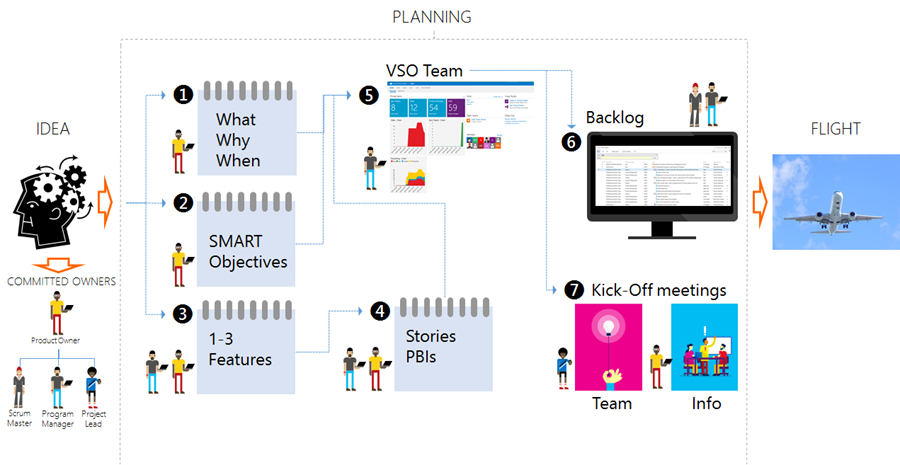Seven major checkpoints involved in starting an ALM Rangers project – Checklist
▲ of Ideas
During the IDEAS phase we collect ideas for gap-filling projects from UserVoice, continuously triage them to unearth win:win opportunities, and look for committed owners to convert them to solutions.
- ? What is a great idea?
Just as there are no bad questions, there are no bad ideas. Ideas that might seem wild to some are to others an indicator of thinking “out of the box” and innovation. An idea should be bold, out of this world, and should offer differentiating innovation. - ? Which ideas are selected?
The best candidates are those with the highest business value, that can be delivered most quickly, and that impose the least risk to the main product line and our mission statement . - ? Who are the committed owners?
- Product Owner is the face of the product, owns the product, makes the tough decisions on scope, and engages other stakeholders as needed.
- Project Lead, also known as Dev Lead, is the team enabler and focuses on fine-tuning the team and representing the team on public forums.
- Program Manager works with stakeholders and customers, focusing on quality, team orchestration and keeping the team and backlog from stagnating.
- Scrum Master mentors and guides the team, encouraging consistent Agile practices.
PLANNING – 7 Major checkpoints
As shown in the illustration below, we move from the IDEA phase, to PLANNING, before the project team takes off to build the solution.
We have seven major checkpoints in our PLANNING phase.
| # | Description | DONE |
| 1 | Product Owner defines the WHAT (vision), WHY (motivation) and WHEN (roadmap) to define the context and give everyone an understanding of what the idea is and why is is important. | [ ] |
| 2 | Product Owner defines SMART objectives to re-enforce why we are considering the idea, to define the acceptance criteria and help the team defines its definition od done (DoD). | [ ] |
| 3 | Product Owner and Program Manager collaborate to defines 1-3 INVEST features, often representing tangible deliverables with our projects. | [ ] |
| 4 | Product Owner and Program Manager collaborate to break the features down into actionable stories represented as product backlog items (PBIs). The team will refine and estimate these stories as part of their planning. | [ ] |
| 5 | Program Manager organizes a Team on Visual Studio, work item tracking and source control services. | [ ] |
| 6 | Program Manager and Scrum Master collaborate to create a groomed DRAFT backlog, broken down into a Epic (idea), Features and Stories. Optionally they will take the opportunity to refine the team dashboard, queries and reports. | [ ] |
| 7 | Project Lead organises a kick-off meeting to share an overview, drives consensus, and allow the team to reach an agreement and plan the next steps in a very short time. The Product Owner typically delivers a training and information sharing session after the kick-off to introduce new technologies, enforce the objectives and features. | [ ] |
- ? Where can I find more details on the above?
See our free Managing Agile OSS Projects with Microsoft Visual Studio Online eBook on MS Press. - ? Why up to 3 features?
The number of features defined per Epic depends on the granularity of each feature. We define one to three “must have” features and optionally one to two “exceeded” features. Defining more features disperses the team’s focus, complicates coordination, and introduces the potential of scope creep.
Final thoughts
The ALM Ranger Program Manager has a unique responsibility if minimising the impact on Product Owners, who are typically busy feature Program Managers, and the impact on the Project Lead and team members, all of whom are part-time volunteers and investing precious family time. The PMs often own the merge and styling of guidance content, ensuring that team members remain focused on the actual content and sharing their real-world experience. Apart from minimising impact, the PMs also own the quality of the deliverables, coordinating resources, shipping the solution, and most importantly collaborating with the communities and users of the solutions.
To find out more see …/tags/pm/.

